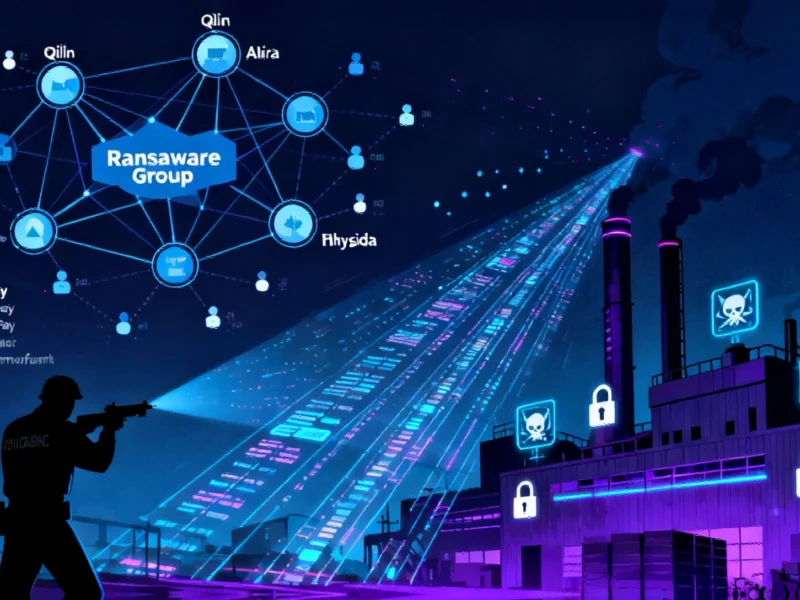Unprecedented Expansion in Ransomware Threat Landscape
The cybersecurity landscape is facing an unprecedented challenge as the number of active ransomware groups reaches record levels, according to GuidePoint Security’s latest quarterly threat intelligence report. The findings reveal a 57% year-over-year increase in ransomware operations, with the total number of distinct groups climbing to 77 – the highest figure ever recorded in the cybersecurity industry. This alarming trend comes despite overall ransomware activity stabilizing, suggesting a fundamental shift in how cybercriminals organize and operate.
Nick Hyatt, Senior Threat Intelligence Analyst at GuidePoint Security, emphasized the significance of these developments, noting that “while overall activity has stabilized, the number of distinct ransomware groups has surged to a record 77.” This phenomenon reflects both the consolidation of skilled operators within major Ransomware as a Service (RaaS) platforms and the continuous emergence of new, often less sophisticated threat actors entering the ecosystem. The ransomware ecosystem diversification represents a critical challenge for security teams worldwide, requiring new defensive strategies and enhanced threat intelligence capabilities.
Manufacturing Sector Bears the Brunt of Attacks
Perhaps the most concerning finding from the Q3 2025 Ransomware & Cyber Threat Report involves the manufacturing sector, which experienced a staggering 26% quarter-over-quarter increase in attacks. This surge highlights the particular vulnerability of industrial operations and supply chain infrastructure to ransomware threats. The manufacturing industry’s complex network of connected systems, combined with the critical nature of production timelines, makes it an attractive target for cybercriminals seeking maximum leverage for extortion.
The report’s analysis of this trend suggests that ransomware groups are increasingly targeting sectors where operational disruption translates directly to significant financial pressure, forcing organizations to consider paying ransoms to restore critical systems. This strategic targeting aligns with broader patterns observed across the industrial monitoring landscape, where security professionals are grappling with increasingly sophisticated threats to operational technology environments.
Established vs. Emerging Threat Actors
The ransomware ecosystem now demonstrates a clear dichotomy between established, sophisticated operations and newer, more agile threat groups. According to the report, well-known ransomware syndicates like Qilin and Akira are streamlining their operations and refining their attack methodologies. These groups represent the mature end of the RaaS spectrum, offering polished services to affiliates and maintaining consistent attack volumes.
Meanwhile, emerging groups such as SafePay and Rhysida demonstrate how smaller, more specialized operations can thrive by maintaining lower profiles and targeting specific vulnerabilities. Hyatt noted that “newer groups such as SafePay demonstrate how even small, insular actors can thrive by staying under the radar,” suggesting that the barrier to entry for ransomware operations continues to lower while the potential rewards remain substantial. This dynamic creates a constantly evolving threat landscape that mirrors the rapid changes seen in industrial computing and streaming technologies, where innovation and adaptation occur at breakneck speed.
Regulatory and Law Enforcement Implications
The Q3 2025 report also examines the evolving regulatory environment surrounding ransomware payments, analyzing how new state rules are affecting victim response strategies. As governments worldwide grapple with the ransomware epidemic, payment regulations have become increasingly complex, creating additional challenges for organizations facing extortion demands.
Law enforcement actions targeting cybercriminal forums and infrastructure have shown some success in disrupting ransomware operations, but the report suggests these efforts face an uphill battle against the rapidly multiplying number of threat groups. The decentralized nature of the current ransomware ecosystem makes coordinated takedowns more challenging, as new groups can quickly emerge to fill voids left by disrupted operations. This persistent threat environment demands continuous innovation in defensive technologies, much like the ongoing advancements in factory automation and efficiency systems that keep industrial operations competitive.
The New Normal: Sustained Vigilance Required
Hyatt’s assessment of the current situation carries significant weight for security professionals: “This ‘new normal’ isn’t a reason for complacency – it underscores the need for sustained vigilance in an increasingly fragmented threat landscape.” The diversification of ransomware groups means that organizations must prepare for attacks from multiple vectors and threat actor profiles, requiring more comprehensive security postures and enhanced incident response capabilities.
The record number of active ransomware groups represents a fundamental shift in the cyber threat landscape that will likely persist throughout 2025 and beyond. Security teams must adapt to this new reality by implementing multi-layered defense strategies, enhancing threat intelligence sharing, and maintaining constant awareness of emerging ransomware tactics and techniques. As the ransomware ecosystem continues to evolve and diversify, the cybersecurity community faces an ongoing challenge that demands innovation, collaboration, and relentless attention to emerging threats.
Based on reporting by {‘uri’: ‘manufacturing.net’, ‘dataType’: ‘news’, ‘title’: ‘Manufacturing.net’, ‘description’: ‘Manufacturing.net provides manufacturing professionals with industry news, videos, trends, and analysis as well as expert blogs and new product information.’, ‘location’: {‘type’: ‘place’, ‘geoNamesId’: ‘5261457’, ‘label’: {‘eng’: ‘Madison, Wisconsin’}, ‘population’: 233209, ‘lat’: 43.07305, ‘long’: -89.40123, ‘country’: {‘type’: ‘country’, ‘geoNamesId’: ‘6252001’, ‘label’: {‘eng’: ‘United States’}, ‘population’: 310232863, ‘lat’: 39.76, ‘long’: -98.5, ‘area’: 9629091, ‘continent’: ‘Noth America’}}, ‘locationValidated’: False, ‘ranking’: {‘importanceRank’: 482874, ‘alexaGlobalRank’: 270100, ‘alexaCountryRank’: 105425}}. This article aggregates information from publicly available sources. All trademarks and copyrights belong to their respective owners.



